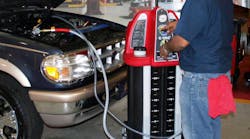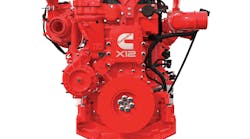Vehicle OEMs keep extending maintenance service schedules further and further out. The question to consider is: do they have the fleet’s best interest in mind? Or, are they just trying to keep the maintenance costs low during the warranty period?
It appears as though some OEs spread their maintenance schedule out further or recommend not to change the fluid at all to achieve lower operational costs.
Various service guidelines
For instance, why do some car and light truck manufacturers recommend changing the fluid at 3,000 while others at 5,000 or 7,000 miles, when they are comparable fluids with similar functions? Why would some manufacturers recommend changing the transmission fluid at 30,000 or 50,000 or 70,000 miles, while others never recommend changing the fluid?
Overall, these fluids are basically performing the same services, transferring similar heat conditions, that break down the fluid’s protective characteristics and lubricity after a while. In addition, most recommended service intervals are based on flat roads, no traffic, no towing, no excessive stop-and-go and no summer heat. Very few areas of the country fall under these conditions.
The same holds true for heavy duty vehicles, with recommendations to replace coolant at 150,000 miles, and transmission fluid at 250,000 miles, for example. Some manufacturers even recommend changing the power steering fluid. Does the fluid really last that long under duress conditions?
Fluid replacement process
Once fluids need to be replaced, how does a fleet change the fluids? The method of draining the used fluid and filling with replacement fluid typically only removes about 50 percent of the used fluid. There are machines available that will exchange the fluids at 80 to 90 percent. Keep in mind, when performing traditional drain-and-fill fluid maintenance, this service must be performed more often compared to using fluid exchange equipment, in order to maintain OE recommendations.
So why is changing the fluid so important? It all depends on the fluid and what it is designed to do. All fluids break down over time from heat and usage. When the fluid breaks down, it does not perform as it was chemically designed. Over time, the fluid can lose its original characteristics. Some changes that may occur include:
- Used fluid will not lubricate as well as when new
- Corrosion protection properties are no longer present
- The fluid will not transfer heat as well
- The viscosity changes
- Oxidation can occur
All of these characteristics can have an adverse effect on the vehicle’s system and performance.
Vehicles that are well maintained can stave off problems that lead to breakdowns and other unnecessary service costs. If vehicles are maintained routinely they run better, maximize fuel efficiency and achieve environmentally friendly ratings. Changing the fluids at regular intervals will minimize problems and save money for the life of that vehicle. It is much cheaper to maintain the vehicle versus repairing, or replacing, the vehicle.
Proper procedures when replacing components
If or when a component fails, it is important to perform that replacement properly to avoid repeat failures.
With A/C systems, it is good practice to flush out the different components when replacing the A/C compressor. The reason is debris from the replaced compressor can end up in the other A/C system components not being replaced. That debris will make its way to the replaced A/C compressor. These particles will restrict the oil flow, thus increasing the chance of another failed compressor.
Many manufacturers will not warranty the replacement components if the system is not flushed properly. The same holds true for powertrains. When replacing a transmission, for instance, debris from the failed transmission will end up in the cooler and lines, along with other connected components that are not being replaced. In the case of transmission systems, it is not only debris, but the cooler could also have waxy varnish buildup. This condition will restrict the flow to the transmission and could lead to transmission failure.
The only way to properly remove the particles and buildup is to use a machine that heats the system to the normal operating temperature and pulsates the fluid.
The heat not only expands the coolers opening, allowing particles to pass through safely, but also acts as a cleaning agent to remove the varnish buildup by returning it to liquid form. The pulsating method circulates the transmission fluid to create the necessary action to thoroughly clean all components of old fluid. This pulsating action helps remove the particles previously trapped in the cooler openings. Using heat and pulsation leads to better flow rate and better performance.
As with the most A/C component manufacturers, nearly every transmission manufacturer and component supplier will not provide warranty if the system is not properly flushed prior to replacing the transmission and or its components.
Proper maintenance and proper repair will lead to lower long-term costs and keep vehicles on the road.
Frank Casale is the vice president of Flo-Dynamics. He began his career in the automotive industry in 1984, working for the purchasing department of a tool warehouse. In 2000, Casale took a position in sales and marketing for an air conditioning company. In 2004, he became the sales manager for Flo-Dynamics and now leads the Flo-Dynamics division. Flo-Dynamics is a division of Norco Industries.





